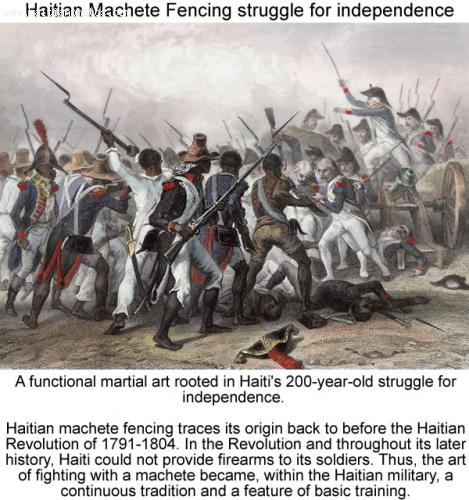ADVERTISEMENT
Machette Fencing
Congolese Slaves Import Tire Machèt
Tire Machèt began as a tribal martial arts skill in the African Congo. When European invaders conquered Haiti, they began importing Congolese slaves, who brought Tire Machèt with them.
The slaves worked on plantations and finally decided to revolt against their masters. They used Tire Machèt as their weapon.
Tire Machèt has endured as a martial art due to the protection it had when Haiti became isolated from the rest of the world. Today, it is a sacred symbol of the Haitian Slave Revolt.
Haitian Army Adopts Tire Machèt as Effective Weapon
When Congolese slaves were brought to Haiti to work the plantations, they imported a tribal martial arts form, Tire Machèt.
On the eve of the Haitian Slave Revolt, Tire Machèt was resurrected as an inexpensive type of weaponry the rebel slaves could use to slaughter plantation owners.
When the Haitian Army saw the value of Tire Machèt, they quickly adopted it as a skill to be mastered in basic training.
Tire Machèt an Effective Weapon for Haitian Slaves
The Créole martial arts form, Tire Machèt, has its roots in African tribal traditions. Brought to Haiti by Congolese slaves, it gained ascendency during a period of isolation Haiti endured from the rest of the world.
Prior to the Haitian Slave Revolt, Tire Machèt became weaponry for rebels to destroy their masters' plantations. The Haitian Army adopted Tire Machèt as part of its training and it has evolved to become a modern martial arts skill imbued with sacredness.




 Duty Free Americas (DFA) store at Toussaint Louverture...
Duty Free Americas (DFA) store at Toussaint Louverture...  Who will be the next president of Haiti?
Who will be the next president of Haiti?  François Nicolas Duvalier Potential Candidate for President of...
François Nicolas Duvalier Potential Candidate for President of...  Port-au-Prince on fire over gas prices hike
Port-au-Prince on fire over gas prices hike  Partial list of privileges enjoyed by Government officials in...
Partial list of privileges enjoyed by Government officials in...  Haitiano-Japanese Naomi Osaka wins the US Open against Serena...
Haitiano-Japanese Naomi Osaka wins the US Open against Serena...  The Petro Caribe Challenge hashtag
The Petro Caribe Challenge hashtag  Paul Eugène Magloire, born in Quartier Morin
Paul Eugène Magloire, born in Quartier Morin 



